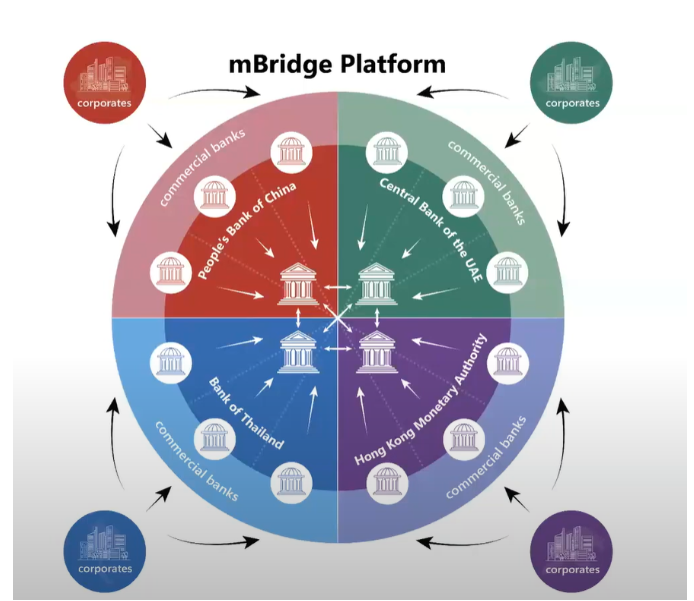Cross-Border W-CBDC in Practice: Project mBridge
Laila Shaheen
5/19/20254 min read


As highlighted earlier, CBDCs can facilitate faster, safer, and cheaper cross-border transactions. It can also provide an alternative to current Western-dominated international payment systems and side-step the USD as an intermediary currency.
The BRICS+ nations, among others, have been actively engaged in cross-border CBDC projects since 2017.
As of 2025, there are 15 active cross-border CBDC projects, three of which involve one or more BRICS+ nations.
To illustrate the viability of peer-to-peer cross-border W-CBDC transactions, this chapter highlights the biggest multinational CBDC project, Project mBridge.
The Multiple CBDC Bridge (mBridge) is a multilateral project involving Thailand, China, the UAE, Hong Kong Monetary Authority, Saudi Arabia, and the Bank for International Settlement (BIS) Innovation Hub. There are also 26 additional observing members comprising central banks from across the globe.
While the project officially launched in 2021, its development can be traced back to 2019 when the central banks of Hong Kong and Thailand initiated their first cross-border multi-CBDC collaboration.
The project aims to build a minimal viable product (MVP) and eventually production-ready multi-CBDC platform that supports real-time, peer-to-peer, cross-border payments and foreign exchange transactions.
In 2022, a six-week pilot program was conducted, during which 305 real-value transactions totaling over $46 million were processed among 41 unique linkages across the four participating currencies. The mBridge project set a record for multi-CBDC pilots in terms of transactions' real value, the number of participants, and the nature of transactions.
It also confirmed the efficiency, security, and viability of peer-to-peer direct multi-currency transactions between different jurisdictions.
Along with the technological innovation facilitating these transactions, the project’s steering committee established a bespoke governance and legal framework tailored to match the platforms’ unique decentralized nature.
In 2024, the BIS confirmed that project mBridge has officially reached the MVP stage. However, soon after, the BIS unexpectedly announced its departure from the venture.
While the BIS General Manager Agustín Carstens stated that the decision was not politically motivated but rather based on the organization's assessment that the project was mature enough to be managed by its member central banks, speculation arose due to the timing coinciding with President Putin’s call for a BRICS Bridge.
From a technical perspective, the mBridge network is built on a custom-designed distributed ledger technology (DLT) that is the intellectual property of, and operated by, the Digital Currency Institute of the People’s Bank of China.
As illustrated in Figure 5, the platform features a common settlement infrastructure, represented by the central circle.
It is also divided into four jurisdictions, each overseen by its respective central bank, which can expand to accommodate additional countries as they join the system.
Each central bank has the ability to onboard and offboard locally regulated financial institutions within its jurisdiction.
Businesses and corporations are considered external to the platform and do not have direct access. If they wish to use mBridge to settle international transactions, they submit a request to a platform's participant.
The arrows indicate the permitted flow of information and funds. Corporations can request a transaction from a participating commercial bank, which then submits the request to the country’s central bank.
The central banks of the two trading countries settle the transaction in real time using their respective currencies at an agreed-upon exchange rate.
They then pass the payment to the commercial bank on the other side, which ultimately delivers it to the recipient.
These unprecedented peer-to-peer linkages effectively eliminate the need for numerous correspondent banks, often Western-based, to process and settle international payments. Instead, only the two countries directly engaged in trade are involved in the transaction.


Figure 5: The mBridge Platform. High Level Network Topology (BIS, 2023)
After reaching MVP status, the project is now welcoming further international participation from both the private sector and central banks.
In the long run, with sufficient international participation, mBridge has the potential to gain significant traction and capture market share from outdated, Western-dominated systems.
What makes this venture particularly powerful from a geopolitical perspective, beyond the fact that China owns the technology's intellectual property and operates it, is its ability to align with the diverse motivations of many nations.
Objectively, mBridge is faster, cheaper, safer, and more transparent than existing systems. Thus, even countries that are not invested in the de-dollarization narrative, per se, may still find it logistically advantageous to sign up.
That said, this transition will not happen overnight. The network effect will play a critical role, and adoption may initially be slow due to significant structural and institutional frictions. Many countries face high sunk costs from decades of investment in the dollar-based system, including infrastructure, legal frameworks, and banking relationships.
Additionally, barriers to change in this case range from economic and technological concerns, such as the cost of integration and interoperability issues, to direct geopolitical pressures, including fears of upsetting existing alliances or becoming entangled in rival spheres of influence.
Still, the mere existence of this multilateral experiment, confirming the viability of a new alternative financial system that is not only immune to western domination but is also cheaper and faster, is a true leap towards a multipolar financial order.
© 2025. The PoliTech Brief. All rights reserved.